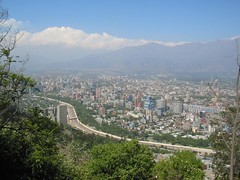Santiago de Chile, a small hotel for travelers run by an indigenous Mapuche, skyscrapers and crumbling houses. From the hill overlooking the city, as a kind of ordeal, you can enjoy a 360 degree view of the capital city, long and endless. Sometimes hidden behind the clouds, the Andes are majestic and snow-capped, in the background you can see the white paradise of Tres Valles and Valle Nevado, the ski resorts that are located only 50 kilometers from Santiago de Chile. The bustling center takes attention away from the phenomena of creative and marginalized life of the vast majority of the population. In the north of Santiago is located a huge landfill where most of the waste of the city is collected. The people who live there have earned the nickname of moscas, in the evocative dialect of Chile. They brave daily fortune, rising with great agility on each garbage truck that arrives at the landfill and they recover valuable pieces such as iron, copper, aluminum, bicycles and any material that can then be recycled or sold on the black market. Another example of creative adaptation is represented here by Don Ignacio, an intelligent man of about fifty years, who completely dedicated to retrieve pieces of wood, glass and metal at the landfill over the last twenty ones. His only goal, brilliantly achieved, was to build a abusive house with the scraps, equipped with every comfort and a strong and personal sense of aesthetics. The city is alive and looks at arts and poetry. The birth of the murales in Chile as a mass phenomenon, dates back to the 1969, at the time of protests against the Vietnam war, From the port of Valparaíso to Santiago de Chile, a few guys repainted the entire pathway of the protests by stopping at each rock along the road with an old Jeep. The Chilean group of murales is called the brigadas Ramona Parra and was born with the aim of achieving the candidacy of Salvador Allende in the propaganda of 1970. The urban murales are made of symbols and letters. The dove, hands, ears, the stars were a new language that has long been popular in the underground of the night.

